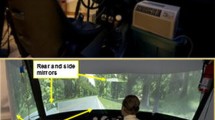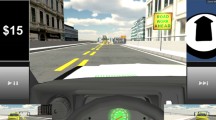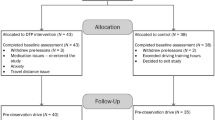Abstract
Investigate how novice drivers with autism spectrum disorder (ASD) differ from experienced drivers and whether virtual reality driving simulation training (VRDST) improves ASD driving performance. 51 novice ASD drivers (mean age 17.96 years, 78% male) were randomized to routine training (RT) or one of three types of VRDST (8–12 sessions). All participants followed DMV behind-the-wheel training guidelines for earning a driver’s license. Participants were assessed pre- and post-training for driving-specific executive function (EF) abilities and tactical driving skills. ASD drivers showed worse baseline EF and driving skills than experienced drivers. At post-assessment, VRDST significantly improved driving and EF performance over RT. This study demonstrated feasibility and potential efficacy of VRDST for novice ASD drivers.



Similar content being viewed by others
References
Adler, L. A., Resnick, S., Kunz, M., & Devinsky, O. (1995). Open-label trial of venlafaxine in adults with attention deficit disorder. Psychopharmacology Bulletin, 31(4), 785–788.
Akinwuntan, A. E., Weerdt, W. D., Feys, H., Pauwels, J., Baten, G., Arno, P., et al. (2005). Effect of simulator training on driving after stroke: A randomized controlled trial. Neurology, 65, 843–850.
Aksan, N., Anderson, S. W., Dawson, J. D., Johnson, A. M., Uc, E. Y., & Rizzo, M. (2012). Cognitive functioning predicts driver safety on road tests 1 and 2 years later. Journal of the American Geriatrics Society, 60, 99–105. doi:10.1111/j.1532-5415.2011.03739.x.
Baddeley, A. (2007). Working memory, thought, and action. New York: Oxford University.
Ball, K., Edwards, J. D., Ross, L. A., & McGwin, G. (2010). Cognitive training decreases motor vehicle collision involvement of older drivers. Journal of the American Geriatrics Society, 58(11), 2107–2113. doi:10.1111/j.1532-5415.2010.03138.x.
Bölte, S. (2004). Computer-based intervention in autism spectrum disorders. In O. T. Ryaskin (Ed.), Focus on autism research (pp. 247–260). New York: Nova Science.
Brooks, J. O., Mossey, E., M., Collins, J. C., & Tyler, P. (2013). An exploratory investigation: are driving simulators appropriate to teach pre-driving skills to young adults with intellectual disabilities? British Journal of Learning Disabilities, 42(2), 204–213.
Cascio, C. N., Carp, J., OʼDonnell, M. B., Tinney, F. J., Bingham, R. C., Shope, J. T., & Falk, E. B. (2014). Buffering social influence: neural correlates of response inhibition predict driving safety in the presence of a peer. Journal of Cognitive Neuroscience, 27(1), 83–95.
Cassavaugh, N. D., & Kramer, A. F. (2009). Transfer of computer-based training to simulated driving in older adults. Applied Ergonomics, 40(5), 943–952.
Casutt, G., Theill, N., Martin, M., Keller, M., & Jäncke, L. (2014). The drive-wise project: driving simulator training increases real driving performance in healthy older drivers. Frontiers in Aging Neuroscience, 6(85). doi:10.3389/fnagi.2014.00085.
Classen, S., & Monahan, M. (2013). Evidence-based review on interventions and determinants of driving performance in teens with attention deficit hyperactivity disorder or autism spectrum disorder. Traffic Injury Prevention, 14(2), 188–193.
Classen, S., Monahan, M., & Hernandez, S. (2013). Indicators of simulated driving skills in adolescents with autism spectrum disorder. The Open Journal of Occupational Therapy, 4(2). Retrieved from http://scholarworks.wmich.edu/ojot/vol1/iss4/2.
Conway, A. A., Kane, M. J., Bunting, M. F., Hambrick, D. Z., Wilhelm, O., & Engle, R. W. (2005). Working memory span tasks: A methodological review and user’s guide. Psychonomic Bulletin and Review, 12(5), 769–786.
Cox, C. V., Wharam, R., Mouran, R., & Cox, D. J. (2009). Does virtual reality driving simulation training transfer to on-road driving in novice drivers? A pilot study. Chronicle of the American Driver and Traffic Safety Education Association, 57(1).
Cox, D. J., Banton, T., Record, S., & Grabman, J. H. (2015a). Does correcting astigmatism with toric contact lenses improve driving safety? A pilot study. Optometry and Vision Science, 92(4), 404–411.
Cox, D. J., Davis, M., Singh, H., Barbour, B., Nidiffer, D., Trudel, T., & Moncrief, R. (2010). Driving rehabilitation for military personnel recovering from traumatic brain injury using virtual reality driving simulation: A feasibility study. Military Medicine, 175(6), 411–416.
Cox, D. J., Merkel, R. L., Kovatchev, B., & Seward, R. (2000). Effect of stimulant medication on driving performance of young adults with attention-deficit hyperactivity disorder: A preliminary double-blind placebo controlled trial. The Journal of nervous and mental disease, 188(4), 230–234.
Cox, D. J., Moncrief, M., Rizzo, M., Fisher, D., Lambert, A., Thomas, S., et al. (2015b). Low hanging fruit: Use of virtual reality simulation in Department of Motor Vehicles to assess minimal competence of novice drivers. In Paper presented at international driving symposium on human factors in driving assessment, training, and vehicle design. Salt Lake City, UT.
Cox, D. J., Taylor, P., & Kovatchev, B. (1999). Driving simulation performance predicts future accidents among older drivers. Journal of the American Geriatrics Society, 47(3), 381–382.
Cox, N. B., Reeve, R. E., Cox, S. M., & Cox, D. J. (2012). Brief report: Driving and young adults with ASD: Parents’ experiences. Journal of Autism and Developmental Disorders, 42, 2257–2262.
Cox, S. M., Cox, D. J., Kofler, M. J., Moncrief, M. A., Johnson, R. J., Cain, S. A., & Reeve, R. E. (2016). Driving simulator performance in adolescents with autism spectrum disorder: The role of executive functions and basic motor skills. Journal of Autism and Developmental Disorders. doi:10.1007/s10803-015-2677-1.
Daly, B. P., Nicholls, E. G., Patrick, K. E., Brinckman, D. D., & Schultheis, M. T. (2014). Driving behaviors in adults with autism spectrum disorders. Journal of Autism and Developmental Disorders, 44(12), 3119–3128. doi:10.1007/s10803-014-2166-y.
Dempster, F. N. (1992). The rise and fall of the inhibitory mechanism: Toward a unified theory of cognitive development and aging. Developmental Review, 12(1), 45–75.
Dickerson, A. E., & Bédard, M. (2014). Decision tool for clients with medical issues: A framework for identifying driving risk and potential to return to driving. Occupational Therapy In Health Care, 28(2), 94–202. doi:10.3109/07380577.2014.903357.
Faul, F., Erdfelder, E., Lang, A. G., & Buchner, A. (2007). G* power 3: A flexible statistical power analysis program for the social, behavioral, and biomedical sciences. Behavior Research Methods, 39(2), 175–191.
Freund, B., Colgrove, L. A., Petrakos, D., & McLeod, R. (2008). In my car the brake is on the right: Pedal errors among older drivers. Accident Analysis and Prevention, 40, 403–409.
Hoffman, J. D., Lee, J. D., Brown, T. L., & McGehee, D. V. (2002). Comparison of driver braking responses in a high-fidelity simulator and on a test track. Transportation Research Record, 1803(1), 59–65.
Hofmann, W., Schmeichel, B. J., & Baddeley, A. D. (2012). Executive functions and self-regulation. Trends in Cognitive Sciences, 16(3), 174–180.
Huang, P., Kao, T., Curry, A. E., & Durbin, D. R. (2012). Factors associated with driving in teens with autism spectrum disorders. Journal of Developmental and Behavioral Pediatrics, 33, 70–74.
Lambert, A. E., Simons-Morton, B. G., Cain, S. A., Weisz, S., & Cox, D. J. (2014). Considerations of a dual-systems model of cognitive development and risky driving. Journal of Research on Adolescence, 24(3), 541–550.
Malik, H., Rakotonirainy, A., & Maire, F. (2009). Correlating eye gaze direction, depth and vehicle information on an interactive. 2009 Australasian Road Safety Research, Policing and Education Conference : Smarter, Safer Directions. Sydney: Sydney Convention and Exhibition Centre.
Mäntylä, T., Karlsson, M. J., & Marklund, M. (2009). Executive control functions in simulated driving. Applied Neuropsychology, 16, 11–18.
Massie, D. L., Campbell, K. L., & Williams, A. F. (1995). Traffic accident involvement rates by driver age and gender. Accident Analysis and Prevention, 27(1), 73–87.
Michon, J. A. (1985). A critical view of driver behaviour models: What do we know, what should we do? In L. Evans, & R. C. Schwing (Eds.), Human behaviour and traffic safety (pp. 485–524). New York: Plenum.
Monahan, M., Classen, S., & Helsel, P. V. (2013). Pre-driving evaluation of a teen with attention deficit hyperactivity disorder and autism spectrum disorder. Canadian Journal of Occupational Therapy, 80(1), 35–41. doi:10.1177/0008417412474221.
Parsons, S., Mitchell, P., & Leonard, A. (2004). The use and understanding of virtual environments by adolescents with autistic spectrum disorders. Journal of Autism and Developmental Disorders, 34(4), 449–466.
Pradhan, A., Pollatsek, A., & Fisher, D. L. (2007). Comparison of trained and untrained novice drivers’ gaze behavior in risky and non-risky scenarios. Proceedings of the fourth international driving symposium on human factors in driver assessment, training and vehicle design. Stevenson, Washington.
Reimer, B., Aleardi, M., Martin, J. M., Coughlin, J. F., & Biederman, J. (2006). Characterizing impaired driving in adults with attention-deficit/hyperactivity disorder: A controlled study. Journal of Clinical Psychiatry, 67(4), 567–574.
Reimer, B., Fried, R., Mehler, B., Joshi, G., Bolfek, A., Godfrey, K. M., & Biederman, J. (2013). Brief report: Examining driving behavior in young adults with high functioning autism spectrum disorders: A pilot study using a driving simulation paradigm. Journal of Autism and Developmental Disorders, 43, 2211–2217.
Ross, V., Jongen, E. M., Brijs, T., Brijs, K., Ruiter, R. A., & Wets, G. (2015a). The relation between cognitive control and risky driving in young novice drivers. Applied Neuropsychology, 22(1), 61–72. doi:10.1080/23279095.2013.838958.
Ross, V., Jongen, E. M., Vanvuchelen, M., Brijs, T., Brijs, K., & Wets, G. (2015b). Exploring the driving behavior of youth with an autism spectrum disorder: a driver instructor questionnaire. 8th international driving symposium on human factors in driver assessment, training and vehicle design. Salt Lake City.
Ross, V., Jongen, E. M., Wang, W., Brijs, T., Brijs, K., Ruiter, R. A., & Wets, G. (2014). Investigating the influence of working memory capacity when driving behavior is combined with cognitive load: An LCT study of young novice drivers. Accident Analysis and Prevention, 62, 377–387.
Sheppard, E., Ropar, D., Underwood, G., & van Loon, E. (2010). Brief report: Driving hazard perception in autism. Journal of Autism and Developmental Disorders, 40, 504–508.
Sheppard, E., Van Loon, E., Underwood, G., & Ropar, D. (2016). Attentional differences in a driving hazard perception task in adults with autism spectrum disorders. Journal of Autism and Developmental Disorders, 1–10.
Strickland, D. (1997). Virtual Reality for the Treatment of Autism. Virtual Reality in Neuro-Psycho-Physiology, 81–86.
Unsworth, N., Heitz, R. P., Schrock, J. C., & Engle, R. W. (2005). An automated version of the operation span task. Behavior Research Methods, 37(3), 498–505.
Vlakveld, W., Romoser, M. R., Mehranian, H., Diete, F., Pollatsek, A., & Fisher, D. L. (2011). Do crashes and near crashes in simulator-based training enhance novice drivers’ visual search for latent hazards? Transportation Research Record, 2265, 153–160.
Wade, J., Bian, D., Zhang, L., Swanson, A., Sarkar, M., Warren, Z., & Sarkar, N. (2014). Design of a Virtual Reality Driving Environment to Assess Performance of Teenagers with ASD. In Universal access in human-computer interaction. Universal access to information and knowledge (pp. 466–474). New York: Springer International Publishing.
Acknowledgments
This project was supported by grant #W81XWH-12-1-0608 from the U.S. Department of Defense. We are indebted to the assistance rendered by Sarah Cain, Addison Walker, Erin Thiemann, Roger Thompson, Paul Barnard, Kristin Lucas, Trevor Johnson, and Rachel Dyke in the execution of this study.
Author Contributions
DJC was the principle investigator, the overall director of the project, and the primary writer of the manuscript. TB was the co-investigator of the project and oversaw data collection at the University of Iowa. He reviewed and critiqued the manuscript. VR did the data analysis for this paper and contributed extensively to the literature review and Results section. MM performed all assessments and VRDST at the University of Virginia and was the overall data manager of the project. He also contributed to the data presentation in this manuscript. RS was the University of Iowa’s project coordinator and performed their VRDS assessments. She did extensive technical editing of the manuscript. GG and RR were the clinicians responsible for the diagnosis of the ASD participants at the University of Iowa and the University of Virginia, respectively. They actively contributed to subject recruitment and they reviewed and critiqued this manuscript.
Author information
Authors and Affiliations
Corresponding author
Ethics declarations
Conflict of interest
Daniel Cox has received grant funding from the Department of Defense, the National institutes of Health, Johnson & Johnson, Purdue Pharmaceuticals and DexCom. Timothy Brown has received grant funding from the Department of Defense, and has performed contractual work for the National Highway Traffic Safety Administration, the Federal Highway Administration, Toyota Motor Company, and the National Institutes of Health. Veerle Ross has received grant funding from the Marie-Marguerite Delacroux support fund. Gary Gaffney has received grant funding from the Department of Defense, and has performed contractual work for the National Highway Traffic Safety Administration, and the National Institutes of Health. Ron Reeve received grant funding from the Department of Defense. Matthew Moncrief and Rose Schmitt declare that they have no conflict of interest.
Ethical Approval
All procedures performed involving human participants were in accordance with the ethical standards of the institutional and national research committee and with the Statement of Principles defined under the Belmont Report. Each site received individual approval from their respective institutional review board.
Informed Consent
All participants either signed an assent form (parents signing a Consent form) or a Consent form if age 18 or older. Before signing, participant and parent were taken to a quiet room, the consent form was reviewed, then parent and participant were left alone to consider the consent form and sign it if in agreement.
Additional information
This is a follow-up to an earlier study: Cox SM, Cox DJ, Kofler MJ, Moncrief MA, Johnson RJ, Lambert AE, Cain S and Reeve RE. Driving simulator performance in adolescents with autism spectrum disorder: The role of executive functions and basic motor skills. Journal of Autism and Developmental Disorders. 46(4), 1379–1391. doi 10.1007/s10803-015-2677-1.
Rights and permissions
About this article
Cite this article
Cox, D.J., Brown, T., Ross, V. et al. Can Youth with Autism Spectrum Disorder Use Virtual Reality Driving Simulation Training to Evaluate and Improve Driving Performance? An Exploratory Study. J Autism Dev Disord 47, 2544–2555 (2017). https://doi.org/10.1007/s10803-017-3164-7
Published:
Issue Date:
DOI: https://doi.org/10.1007/s10803-017-3164-7




